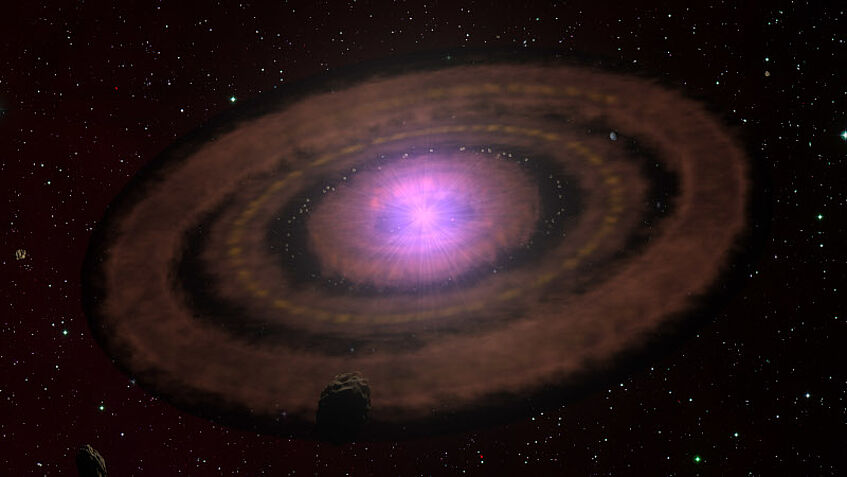ALMA observes hundreds of planet-forming disks

Artistic impression of a typical planet-forming disk around a young star. Gas and dust form dense rings from which planets will form.
Image: MPIA graphics department
A group of astronomers, including Alvaro Hacar from the Institute of Astrophysics of the University of Vienna, has analyzed the mass distribution of over 870 planet-forming disks in the Orion A cloud. This unprecedented large sample of disks allowed for a statistical description of their properties by using an innovative data processing scheme. The results indicate that at least within the next 1000 light-years, planet-forming disks and planetary systems typically evolve in similar ways.
This study represents a unique opportunity to shed light on the intriguing question on how likely it is for other planetary systems to evolve in a similar way like our own.
“Up to now, we didn’t know for sure which properties dominate the evolution of planet-forming disks around young stars”, says Sierk van Terwisga, who is a scientist at the Max Planck Institute for Astronomy in Heidelberg, Germany and lead author of the article published in Astronomy & Astrophysics today.
The disk mass is the key property when studying the evolution of planet-forming disks, as it determines how much material is available to assemble planets. This quantity depends on internal disk properties such as age, chemical composition, or the parental cloud dynamics from which the young stars with their disks emerge.
To disentangle the various contributions, the team of astronomers selected a large and well-known region of young stars with disks, the Orion A cloud, approximately 1350 light-years away from Earth.
“The statistical significance provided by our sample of 873 disks around young stars was crucial to discern small variations in the disk mass depending on age and even on the local environments inside the Orion A cloud,” Alvaro Hacar, a co-author and scientist at the University of Vienna, Austria, explains.
The observations needed to measure disk masses were performed at the Atacama Large Millimeter/Submillimeter Array (ALMA) located on the Chajnantor Plateau in the Chilean Atacama Desert. ALMA consists of 66 parabolic antennas, functioning as a single telescope. The scientists applied an observing mode to target each disk at a wavelength of about 1.2 millimetres, a spectral range in which cold disks are bright.

Orion A star-forming cloud, at a distance of about 1350 light-years, as observed by the SPIRE (Spectral and Photometric Imaging Receiver) instrument on-board the Herschel Space Telescope. It traces the large-scale distribution of cold dust. Individual star-forming regions are indicated by their labels. The locations of planet-forming disks (+) observed with ALMA are indicated, while disks with dust masses above an equivalent of 100 earth masses appear as blue dots. The famous Orion Nebula, visible to the naked eye in the sky, hosts the Orion Nebula Cluster (ONC), including several massive stars emitting intense radiation.
Image: S.E. van Terwisga et al./MPIA
Combining and calibrating data from several dozens of ALMA telescopes is a quite challenging task. For such a large dataset it would have taken months, when following the standard procedure. The team developed a new data reduction scheme using parallel computing.
“Our new approach improved the processing speed by a factor of 900,” co-author Raymond Oonk from the collaborating IT service provider SURF points out.
It took less than a day for the 3000 CPU hours required to finish the task and prepare the data for subsequent analysis!
With this approach, the astronomers determined the disks’ dust masses. Altogether, Orion A planet-forming disks add up to a few hundred Earth-masses of dust. However, from the 873 disks, only 20 hold dust equivalent to 100 earths or more. The number of disks decrease for large masses. The results also show that disk masses also decline for older disks. This is not surprising, as one of the main reasons why dust is removed from disks is planet formation. This large sample of disks show a very strong dependence of disk mass with age, hinting to a similar evolution of planet-forming disks.
“The unprecedented size of our new ALMA sample, larger than all previous surveys combined, opens a new window on the study of the formation and evolution of entire disk populations at cloud scales”, remarks Alvaro Hacar.
Additional information
The team consists of S.E. van Terwisga (Max Planck Institute for Astronomy, Heidelberg, Germany), A. Hacar (Department of Astrophysics, University of Vienna, Austria), E.F. van Dishoeck (Leiden Observatory, Leiden University, The Netherlands [LObs]; Max Planck Institute for extraterrestrial Physics, Garching bei München, Germany), R. Oonk (SURF, Leiden, The Netherlands; LObs; Netherlands Institute for Radio Astronomy (ASTRON), Dwingeloo, The Netherlands), and S. Portegies Zwart (LObs).
The Atacama Large Millimeter/Submillimeter Array (ALMA) is a partnership between the European Southern Observatory (ESO), the U.S. National Science Foundation (NSF) and the National Institutes of Natural Sciences (NINS) of Japan in cooperation with the Republic of Chile. ALMA is funded by ESO on behalf of its Member States, by NSF in cooperation with the National Research Council of Canada (NRC) and the National Science Council of Taiwan (NSC) and by NINS in cooperation with the Academia Sinica (AS) in Taiwan and the Korea Astronomy and Space Science Institute (KASI).
Scientific contact
Assoz. Prof. Dr. Alvaro Hacar Gonzalez, MA
Türkenschanzstraße 17 (Sternwarte)
1180 Wien
Room: T16.2
Links
SODA Website: https://emerge.univie.ac.at/results/soda-survey/
SURF Website: https://www.surf.nl/en
ALMA Website: https://www.eso.org/public/teles-instr/alma/
Alvaro Hacar Website: https://www.alvarohacar.com/
MPIA press release: www.mpia.de/news/science/2022-07-soda
Original paper
S.E. van Terwisga et al., “Survey of Orion Disks with ALMA (SODA). I: Cloud-level demographics of 873 protoplanetary disks”, Astronomy & Astrophysics (2022). DOI:
